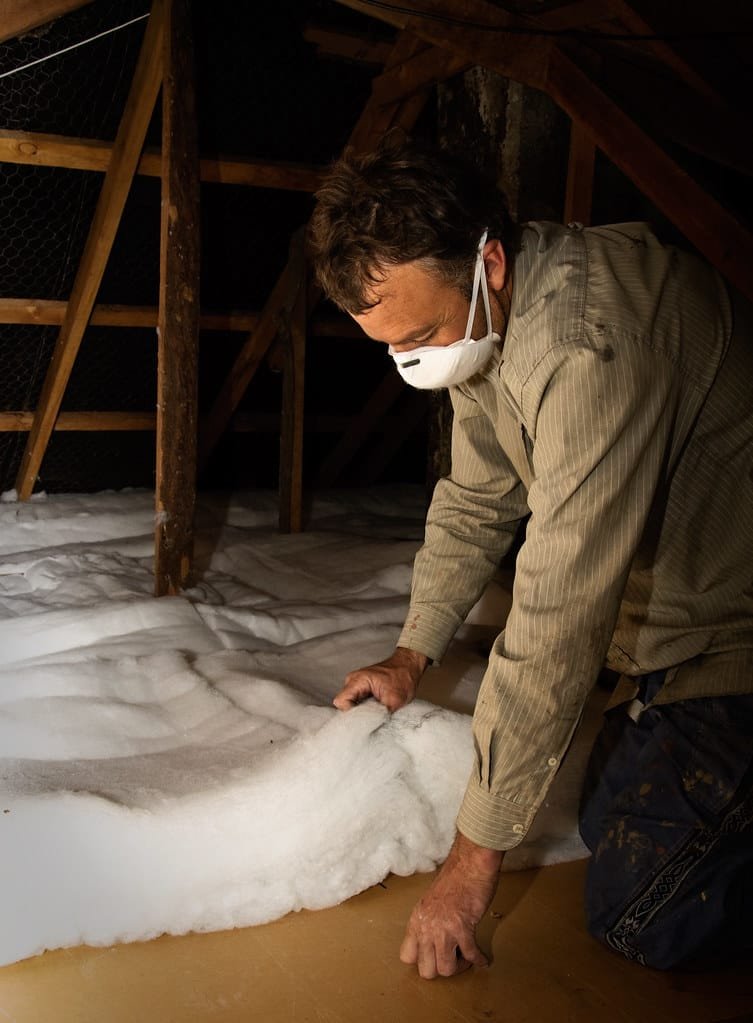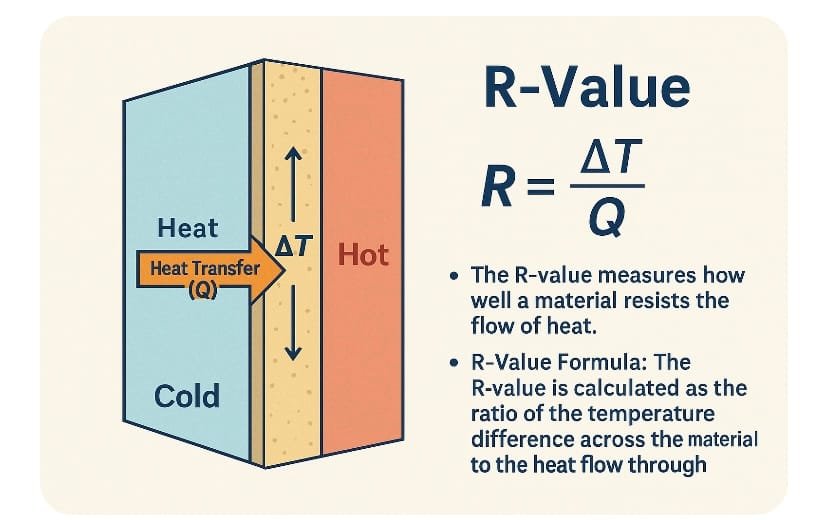- 1. Fiberglass Insulation
- 2. Spray Foam Insulation
- 3. Cellulose Insulation
- 4. Foam Board Insulation
- 5. Mineral Wool Insulation (Rockwool)
- 6. Cotton (Denim) Insulation
- 7. Radiant Barriers
- 8. Sheep’s Wool Insulation
- What Is R-Value?
- The R-Value Formula:
- Everyday Meaning:
- Key Points about R-value:
- Typical R-values for Different Insulation Types:
- Typical R-values for Different Insulation Types:
cc5b9Explaining Insulation and R-Value

We’re explaining insulation and R-value. Several types of insulation are common in residential spaces. Each has its benefits depending on the climate, budget, and specific needs of the home. Here are the main types:
1. Fiberglass Insulation
- Form: Available in batts (rolls) or loose-fill.
- Material: Made from fine glass fibres.
- Pros: Affordable, widely available, easy to install.
- Cons: It requires protective gear during installation and is less effective in preventing air leaks.
2. Spray Foam Insulation
- Form: Expanding foam sprayed into walls and ceilings.
- Material: Polyurethane or isocyanate-based.
- Pros: Seals cracks and gaps, provides excellent thermal resistance (high R-value), acts as an air barrier.
- Cons: More expensive, requires professional installation.
3. Cellulose Insulation
- Form: Loose-fill blown into wall cavities or attic spaces.
- Material: Recycled paper products, often treated with fire retardants.
- Pros: Environmentally friendly, good at filling small gaps.
- Cons: Prone to settling over time, can absorb moisture.
4. Foam Board Insulation
- Form: Rigid panels, installed inside or outside walls, floors, or roofs.
- Material: Polystyrene, polyisocyanurate, or polyurethane.
- Pros: High R-value for relatively little thickness, moisture-resistant.
- Cons: More expensive, difficult to install in irregular spaces.
5. Mineral Wool Insulation (Rockwool)
- Form: Batts or loose-fill.
- Material: Made from natural minerals like basalt or recycled slag.
- Pros: Fire-resistant, excellent soundproofing, and moisture-resistant.
- Cons: Higher cost compared to fiberglass.
6. Cotton (Denim) Insulation
- Form: Batts.
- Material: Recycled denim or cotton fibers.
- Pros: Eco-friendly, non-toxic, excellent sound absorption.
- Cons: Expensive, not as readily available.
7. Radiant Barriers
- Form: Reflective materials (usually aluminum) installed in attics.
- Purpose: Reflects heat away rather than absorbing it.
- Pros: Works well in hot climates to reduce cooling costs.
- Cons: Limited effectiveness in cooler climates. It will need to be paired with other insulation for full effectiveness.
8. Sheep’s Wool Insulation
- Form: Batts or loose-fill.
- Material: Natural sheep wool.
- Pros: Sustainable, non-toxic, naturally fire-resistant, moisture-regulating.
- Cons: Costlier than fiberglass or cellulose.
Each type of insulation has its best use cases depending on whether you’re insulating walls, attics, basements, or floors.
What Is R-Value?
R-value measures how well a material resists the flow of heat for walls, roofs, floors, and even windows.

- A high R-value means the material is better at keeping heat in (or out)—great for energy efficiency.
- A low R-value means heat moves through the material more easily.
The R-Value Formula:
Mathematically, R-value is:
[R = \frac{\Delta T}{Q}]
Where:
- ( \Delta T ) is the temperature difference across the material (in degrees Celsius or Fahrenheit).
- ( Q ) is the rate of heat transfer through the material (how fast heat moves through it).
Think of it like this:
If two sides of a wall are very different temperatures (big ( \Delta T )), and not much heat is getting through (small ( Q )), then your R-value is high. That’s good!
Everyday Meaning:
If you touch a well-insulated wall in winter and it doesn’t feel cold, that’s high R-value insulation doing its job. It’s stopping heat from inside your house from warming the cold outdoors.
Key Points about R-value:
- R-value depends on Thickness: The R-value of a material is typically given per inch of thickness. The total R-value increases as the material becomes thicker.
- Climate Impact: The ideal R-value for your home depends on the climate. In colder regions, higher R-values are recommended to keep heat in during the winter, while in hotter regions, it’s used to keep heat out.
- Combined R-values: When different layers of materials are used in combination (e.g., a wall made of insulation, drywall, and exterior siding), the R-values of each layer can be added together to get the total R-value for the system.
Typical R-values for Different Insulation Types:
- The R-value is a measure of how well a material resists the flow of heat. It is used to rate the insulating power of various materials, including insulation. The higher the R-value, the better the material is at insulating, meaning it slows down the transfer of heat more effectively.
- Key Points about R-value:
- R-Value Formula: The R-value is calculated as the ratio of the temperature difference across the material to the heat flow through the material. Mathematically:
[ R = \frac{\Delta T}{Q} ]
where ( \Delta T ) is the temperature difference, and ( Q ) is the heat transfer. - Higher R-value = Better Insulation: Materials with higher R-values offer more resistance to heat flow, which means they are better insulators. For example, a wall insulated with R-30 insulation will provide more thermal resistance than one insulated with R-15.
- R-value Depends on Thickness: The R-value of a material is typically given per inch of thickness. The total R-value increases as the material becomes thicker.
- Climate Impact: The ideal R-value for your home depends on the climate. In colder regions, higher R-values are recommended to keep heat in during the winter, while in hotter regions, it’s used to keep heat out.
- Combined R-values: When different layers of materials are used in combination (e.g., a wall made of insulation, drywall, and exterior siding), the R-values of each layer can be added together to get the total R-value for the system.
Typical R-values for Different Insulation Types:
- Fiberglass batt: R-3.1 to R-4.3 per inch
- Spray foam: R-3.5 to R-6.5 per inch
- Cellulose: R-3.1 to R-3.8 per inch
- Foam board: R-4 to R-6 per inch
- Choosing the right R-value helps ensure your home stays energy efficient by reducing heating and cooling costs.
So that’s me, explaining Insulation and R-value.
